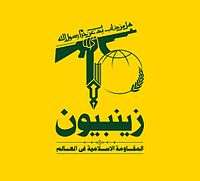Liwa Zainebiyoun
| Liwa Zainebiyoun لواء زينبیون | |
|---|---|
| Participant in the Syrian Civil War | |
|
Official Flag of Liwa Zainabiyoon | |
| Active | late 2014 – present[1] |
| Ideology | Shia Jihadism |
| Area of operations |
Damascus Aleppo Daraa |
| Strength | "Several hundred"[2] - 1,000[3] |
| Allies |
|
| Opponents |
|
| Battles and wars | Battle of Aleppo |
The Followers of Zainab Brigade (لواء زينبیون, Liwa Zainebiyoun or Liwa Zainabiyoon) is a pro-government brigade fighting in Syria composed of Shia Pakistanis.[4][5] It draws recruits from Shia Pakistanis living in Iran, Shia Hazara refugees living in Pakistan,[5] and native Shia of Parachinar and Khyber-Pakhtunkhwa.[1] It was formed and trained by the Iranian Revolutionary Guards and operates under their command.[5] Initially tasked with defending the Sayyidah Zaynab Mosque,[6][7] it has since entered frontlines across Syria.[1] Its dead are buried primarily in Iran.[5][7]
History
Pakistanis have been fighting in Syria since 2013.[6] They originally fought in the Afghan Liwa Fatemiyoun, and only became numerous enough to warrant a distinct brigade in early 2015.[1] Like other Shia foreign brigades in Syria, it is funded, trained, and overseen by the Iranian Revolutionary Guard Corps.[3][8] Its official purpose is to defend the Sayyidah Zaynab Mosque (the shrine of Zaynab bint Ali, sister of Imam Hussain and granddaughter of Mohammed) and other Shia holy sites in Syria.[6] It operates primarily in Damascus defending these holy sites. However, since 2015, it has also engaged in offensive action around Daraa[5][9] and Aleppo, along with other foreign Shia fighters.[1]
According to an advertisement by the group, fighters receive salaries of 120,000 Rs ($1200) per month. They are trained for 45 days initially and 6 months in Syria.[3] Most fighters are Pakistani nationals from Iran.[1][8] Many also come from the Shia-majority Pashtun city Parachinar.[3][10]
On April 9, 2015, 7 fighters were killed defending the Imam Hasan Mosque and were buried in Qom, Iran.[6] In March 2016, 6 fighters were killed defending the Imam Reza shrine, also buried in Qom.[11] On April 23, 5 more fighters were killed.[12] An estimated 69 fighters were killed between November 2014 and March 2016.[1]
Reaction in Pakistan
In December 2015, a bomb killed 23 and injured 30 in Parachinar. Terrorist group Lashkar-e-Jhangvi claimed responsibility, and said that it was “revenge [for] the crimes against Syrian Muslims by Iran and Bashar al-Assad” and threatened continued terror attacks if Parachinar citizens did not “stop sending people to take part in Syrian war”.[10]
See also
References
- 1 2 3 4 5 6 7 "Liwa Zainebiyoun: Syria's Pakistani Fighters". iraqeye.
- ↑ Robert Fisk (26 February 2016). "Syria civil war: State-of-the-art technology gives President Assad's army the edge". The Independent.
- 1 2 3 4 "Iran recruits Pakistani Shias for combat in Syria". The Express Tribune. 11 December 2015.
- ↑ "Liwa Zainebiyoun".
- 1 2 3 4 5 "Meet the Zainebiyoun Brigade: An Iranian Backed Pakistani Shia Militia Fighting in Syria". Retrieved 28 April 2016.
- 1 2 3 4 Farhan Zahid (27 May 2016). "The Zainabiyoun Brigade: A Pakistani Shiite Militia Amid the Syrian Conflict". Terrorism Monitor Volume.
- 1 2 "Funeral Service for Seven Pakistani Militants Killed in Syria; Qom, Iran, Apr 2015". Konflictcam.
- 1 2 http://www.rferl.org/content/persian-letters-afghans-pakistanis-killed-fighting-in-syria-for-iran/26977907.html
- ↑ "Iran Tightens Its Grip On Syria Using Syrian And Foreign Forces". MEMRI. May 5, 2015.
- 1 2 Mehdi Hussain (December 13, 2015). "At least 23 killed, 30 injured in Parachinar blast". The Express Tribune.
- ↑ "The Zainabiyoun Brigade". Farda News. 3 March 2016.
- ↑ http://www.tabnak.ir/fa/news/494084/%D9%BE%DB%8C%DA%A9%D8%B1-%DB%B5-%D8%B4%D9%87%DB%8C%D8%AF-%D9%85%D8%AF%D8%A7%D9%81%D8%B9-%D8%AD%D8%B1%D9%85-%D8%AF%D8%B1-%D9%82%D9%85-%D8%AA%D8%B4%DB%8C%DB%8C%D8%B9-%D8%B4%D8%AF
